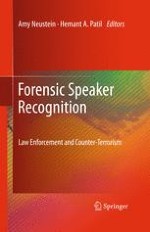
2012 | OriginalPaper | Buchkapitel
1. Historical and Procedural Overview of Forensic Speaker Recognition as a Science
verfasst von : Kanae Amino, Ph.D., Takashi Osanai, Ph.D., Toshiaki Kamada, B.E., Hisanori Makinae, Ph.D., Takayuki Arai, Ph.D.
Erschienen in: Forensic Speaker Recognition
Verlag: Springer New York
Aktivieren Sie unsere intelligente Suche, um passende Fachinhalte oder Patente zu finden.
Wählen Sie Textabschnitte aus um mit Künstlicher Intelligenz passenden Patente zu finden. powered by
Markieren Sie Textabschnitte, um KI-gestützt weitere passende Inhalte zu finden. powered by